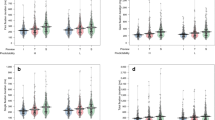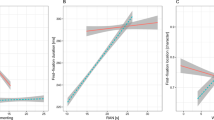Abstract
This study aimed to investigate the effects of contextual predictability on orthographic and phonological activation during Chinese sentence reading by Cantonese-speaking readers using the error disruption paradigm. Participants’ eye fixations and pupil sizes were recorded while they silently read Chinese sentences containing homophonic, orthographic, and unrelated errors. Sentences had varying amounts of contextual information leading up to target words such that some targets were more predictable than others. Results of the fixation time analysis indicated that orthographic effects were significant in first fixation and gaze duration, while phonological effects emerged later in total reading time. However, interactions between predictability and the homophonic condition were found in gaze duration. These results suggest that, while Cantonese readers activate word meanings primarily through orthography in early processing, early phonological activation can occur when facilitated by semantics in high-constraint sentence contexts. Analysis of pupillary response measurements revealed that participants’ pupil sizes became larger when they read words containing orthographic errors, suggesting that orthographic error recovery processes significantly increase cognitive load.


Similar content being viewed by others
Notes
Chinese pronunciations shown in the Cantonese romanization system, Jyutping.
Traditional characters are those most widely used in Taiwan, Hong Kong, and Macau, in contrast to simplified characters used in mainland China.
The N400 is negative-going potential which peaks around 400 ms after the onset of the stimulus. Priming studies have shown its amplitude to be affected by various properties of the prime such as orthographic, phonological and semantic relatedness. .
During reading, the parafoveal range encompasses 1-–2 words beyond the word being directly fixated (Vasilev & Angele, 2017).
References
Akaike, H. (1998). Information theory and an extension of the maximum likelihood principle. In E. Parzen, K. Tanabe, & G. Kitagawa (Eds.), Selected papers of Hirotugu Akaike. Springer series in statistics (pp. 199–213). New York, NY: Springer.
Ariel, R., & Castel, A. D. (2014). Eyes wide open: Enhanced pupil dilation when selectively studying important information. Experimental Brain Research, 232(1), 337–344. https://doi.org/10.1007/s00221-013-3744-5.
Baayen, R. H., Davidson, D. J., & Bates, D. M. (2008). Mixed-effects modeling with crossed random effects for subjects and items. Journal of Memory and Language, 59(4), 390–412.
Bates, D., Maechler, M., & Bolker, B. (2012). lme4: Linear mixed-effects models using S4 classes (2011). R package version 0.999375-42.
Beatty, J., & Lucero-Wagoner, B. (2000). The pupillary system. Handbook of Psychophysiology, 2, 142–162.
Ben-Nun, Y. (1986). The use of pupillometry in the study of on-line verbal processing: Evidence for depths of processing. Brain and Language, 28(1), 1–11. https://doi.org/10.1016/0093-934X(86)90086-6.
Briesemeister, B. B., Hofmann, M. J., Tamm, S., Kuchinke, L., Braun, M., & Jacobs, A. M. (2009). The pseudohomophone effect: Evidence for an orthography–phonology-conflict. Neuroscience Letters, 455(2), 124–128.
Carpenter, P. A., & Daneman, M. (1981). Lexical retrieval and error recovery in reading: A model based on eye fixations. Journal of Verbal Learning and Verbal Behavior, 20(2), 137–160. https://doi.org/10.1016/S0022-5371(81)90357-1.
Chan, S. D. (2007). Hong Kong primary school vocabulary learning list. Wan Chai: Hong Kong Education Bureau.
Coltheart, M., Rastle, K., Perry, C., Langdon, R., & Ziegler, J. (2001). DRC: A dual route cascaded model of visual word recognition and reading aloud. Psychological Review, 108(1), 204–256.
Conklin, K., Pellicer-Sánchez, A., & Carrol, G. (2018). Eye-tracking: A guide for applied linguistics research. Cambridge: Cambridge University Press.
Coyne, J., & Sibley, C. (2016). Investigating the use of two low cost eye tracking systems for detecting pupillary response to changes in mental workload. Proceedings of the Human Factors and Ergonomics Society Annual Meeting, 60(1), 37–41. https://doi.org/10.1177/1541931213601009.
Dai, L., Liu, B., Xia, Y., & Wu, S. (2008). Measuring semantic similarity between words using HowNet. International Conference on Computer Science and Information Technology, 2008, 601–605.
Dalmaijer, E. (2014). Is the low-cost EyeTribe eye tracker any good for research? PeerJ PrePrints.,. https://doi.org/10.7287/peerj.preprints.585v1.
Daneman, M., & Reingold, E. (1993). What eye fixations tell us about phonological recoding during reading. Canadian Journal of Experimental Psychology, 2, 153.
Daneman, M., & Reingold, E. M. (2000). Do readers use phonological codes to activate word meanings? Evidence from eye movements. In A. Kennedy, D. Heller, J. Pynte, & R. Radach (Eds.), Reading as a perceptual process (pp. 447–474). Amsterdam: North-Holland.
Daneman, M., Reingold, E. M., & Davidson, M. (1995). Time course of phonological activation during reading: Evidence from eye fixations. Journal of Experimental Psychology. Learning, Memory, and Cognition, 21(4), 884.
Denisowski, P. (2005). CEDICT: Chinese-English dictionary. Retrieved February 13, 2019, from https://www.mdbg.net/chinese/dictionary?page=cc-cedict.
Dong, Z., Dong, Q., & Hao, C. (2006). HowNet and the computation of meaning.
Feng, G., Miller, K., Shu, H., & Zhang, H. (2001). Rowed to recovery: The use of phonological and orthographic information in reading Chinese and English. Journal of Experimental Psychology. Learning, Memory, and Cognition, 27(4), 1079.
Friedman, D., Hakerem, G., Sutton, S., & Fleiss, J. L. (1973). Effect of stimulus uncertainty on the pupillary dilation response and the vertex evoked potential. Electroencephalography and Clinical Neurophysiology, 34(5), 475–484. https://doi.org/10.1016/0013-4694(73)90065-5.
Frost, R. (1998). Toward a strong phonological theory of visual word recognition: True issues and false trails. Psychological Bulletin, 123(1), 71.
Gao, J., Fan, K., & Fei, J. (1993). Xiandai hanzi xue [The study of modern Chinese characters]. Beijing: Higher Education Press.
Ho, H. H., & Kwan, T. W. (2001). Hong Kong, Mainland China & Taiwan: Chinese character frequency-A trans-regional, diachronic survey. Retrieved February 11, 2017, from https://humanum.arts.cuhk.edu.hk/Lexis/chifreq/.
Hoeks, B., & Levelt, W. J. M. (1993). Pupillary dilation as a measure of attention: A quantitative system analysis. Behavior Research Methods, Instruments, & Computers, 25(1), 16–26. https://doi.org/10.3758/BF03204445.
Hyönä, J., & Pollatsek, A. (2000). Processing of Finnish compound words in reading. In A. Kennedy, R. Radach, D. Heller, & J. Pynte (Eds.), Reading as a perceptual process (pp. 65–87). Amsterdam: North-Holland. https://doi.org/10.1016/B978-008043642-5/50006-1.
Inhoff, A. W. (1984). Two stages of word processing during eye fixations in the reading of prose. Journal of Verbal Learning and Verbal Behavior, 23(5), 612–624. https://doi.org/10.1016/S0022-5371(84)90382-7.
Jared, D., Levy, B. A., & Rayner, K. (1999). The role of phonology in the activation of word meanings during reading: Evidence from proofreading and eye movements. Journal of Experimental Psychology: General, 128(3), 219–264. https://doi.org/10.1037//0096-3445.128.3.219.
Karn, K. S. (2000). “Saccade pickers” vs. “fixation pickers”: The effect of eye tracking instrumentation on research. Proceedings of the 2000 symposium on eye tracking research & applications. https://doi.org/10.1145/355017.355030.
Klingner, J., Kumar, R., & Hanrahan, P. (2008). Measuring the task-evoked pupillary response with a remote eye tracker. Proceedings of the 2008 symposium on eye tracking research & applications - ETRA’08, 69. https://doi.org/10.1145/1344471.1344489.
Leinenger, M. (2014). Phonological coding during reading. Psychological Bulletin, 140(6), 1534–1555. https://doi.org/10.1037/a0037830.
Leube, A., Rifai, K., & Wahl, S. (2017). Sampling rate influences saccade detection in mobile eye tracking of a reading task. Journal of Eye Movement Research, 10, 3.
Linguistic Society of Hong Kong. (1997). Hong Kong jyutping character table. Hong Kong: Linguistic Society of Hong Kong Press.
Lo, S., & Andrews, S. (2015). To transform or not to transform: Using generalized linear mixed models to analyse reaction time data. Frontiers in Psychology. https://doi.org/10.3389/fpsyg.2015.01171.
MacCallum, R. C., Zhang, S., Preacher, K. J., & Rucker, D. D. (2002). On the practice of dichotomization of quantitative variables. Psychological Methods, 7(1), 19.
Perfetti, C., Cao, F., & Booth, J. (2013). Specialization and universals in the development of reading skill: How Chinese research informs a universal science of reading. Scientific Studies of Reading : The Official Journal of the Society for the Scientific Study of Reading, 17(1), 5–21. https://doi.org/10.1080/10888438.2012.689786.
Perfetti, C., Liu, Y., & Tan, L. H. (2005). The lexical constituency model: Some implications of research on Chinese for general theories of reading. Psychological Review, 112(1), 43.
Perfetti, C. A., Zhang, S., & Berent, I. (1992). Chapter 13 reading in English and Chinese: Evidence for a “universal” phonological principle. Advances in Psychology, 94, 227–248. https://doi.org/10.1016/S0166-4115(08)62798-3.
Peysakhovich, V., Causse, M., Scannella, S., & Dehais, F. (2015). Frequency analysis of a task-evoked pupillary response: Luminance-independent measure of mental effort. International Journal of Psychophysiology, 97(1), 30–37. https://doi.org/10.1016/j.ijpsycho.2015.04.019.
R Development Core Team. (2014). R: A language and environment for statistical computing. Vienna: R Foundation for Statistical Computing.
Raisig, S., Hagendorf, H., & van der Meer, E. (2012). The role of temporal properties on the detection of temporal violations: Insights from pupillometry. Cognitive Processing, 13(1), 83–91. https://doi.org/10.1007/s10339-011-0413-0.
Raney, G. E., Campbell, S. J., & Bovee, J. C. (2014). Using eye movements to evaluate the cognitive processes involved in text comprehension. Journal of Visualized Experiments. https://doi.org/10.3791/50780.
Rayner, K. (1998). Eye movements in reading and information processing: 20 years of research. Psychological Bulletin, 124(3), 372.
Rayner, K. (2009). Eye movements and attention in reading, scene perception, and visual search. Quarterly Journal of Experimental Psychology, 62(8), 1457–1506. https://doi.org/10.1080/17470210902816461.
Rayner, K., Pollatsek, A., & Binder, K. S. (1998). Phonological codes and eye movements in reading. Journal of Experimental Psychology. Learning, Memory, and Cognition, 24(2), 476.
Rayner, K., & Well, A. D. (1996). Effects of contextual constraint on eye movements in reading: A further examination. Psychonomic Bulletin & Review, 3(4), 504–509.
Sereno, S. C., Hand, C. J., Shahid, A., Yao, B., & O’Donnell, P. J. (2017). Testing the limits of contextual constraint: Interactions with word frequency and parafoveal preview during fluent reading. The Quarterly Journal of Experimental Psychology, 71(1), 1–24. https://doi.org/10.1080/17470218.2017.1327981.
Snell, J., Mathôt, S., Mirault, J., & Grainger, J. (2018). Parallel graded attention in reading: A pupillometric study. Scientific Reports, 8(1), 3743. https://doi.org/10.1038/s41598-018-22138-7.
Steinhauer, S., & Zubin, J. (1982). Vulnerability to schizophrenia: Information processing in the pupil and event-related potential. In E. Usdin, & I. Hanin (Eds.), Biological markers in psychiatry and neurology (pp. 371–385). Elsevier. https://doi.org/10.1016/B978-0-08-027987-9.50042-1.
Titz, J., Scholz, A., & Sedlmeier, P. (2018). Comparing eye trackers by correlating their eye-metric data. Behavior Research Methods, 50(5), 1853–1863. https://doi.org/10.3758/s13428-017-0954-y.
Van Orden, G. C. (1987). A ROWS is a ROSE: Spelling, sound, and reading. Memory & Cognition, 15(3), 181.
Vasilev, M., & Angele, B. (2017). Parafoveal preview effects from word N + 1 and word N + 2 during reading: A critical review and Bayesian meta-analysis. Psychonomic Bulletin & Review, 24(3), 666–689. https://doi.org/10.3758/s13423-016-1147-x.
Wong, K. F. E., & Chen, H.-C. (1999). Orthographic and phonological processing in reading Chinese text: Evidence from eye fixations. Language and Cognitive Processes, 14(5–6), 461–480.
Yan, Guoli, Tian, Hongjie, Bai, Xuejun, & Rayner, K. (2006). The effect of word and character frequency on the eye movements of Chinese readers. British Journal of Psychology, 97(2), 259–268. https://doi.org/10.1348/000712605X70066.
Zhou, W., Shu, H., Miller, K., & Yan, M. (2018). Reliance on orthography and phonology in reading of Chinese: A developmental study. Journal of Research in Reading. https://doi.org/10.1111/1467-9817.12111/full.
Author information
Authors and Affiliations
Corresponding author
Additional information
Publisher's Note
Springer Nature remains neutral with regard to jurisdictional claims in published maps and institutional affiliations.
Rights and permissions
About this article
Cite this article
Thierfelder, P., Durantin, G. & Wigglesworth, G. The Effect of Word Predictability on Phonological Activation in Cantonese Reading: A Study of Eye-Fixations and Pupillary Response. J Psycholinguist Res 49, 779–801 (2020). https://doi.org/10.1007/s10936-020-09713-8
Published:
Issue Date:
DOI: https://doi.org/10.1007/s10936-020-09713-8




